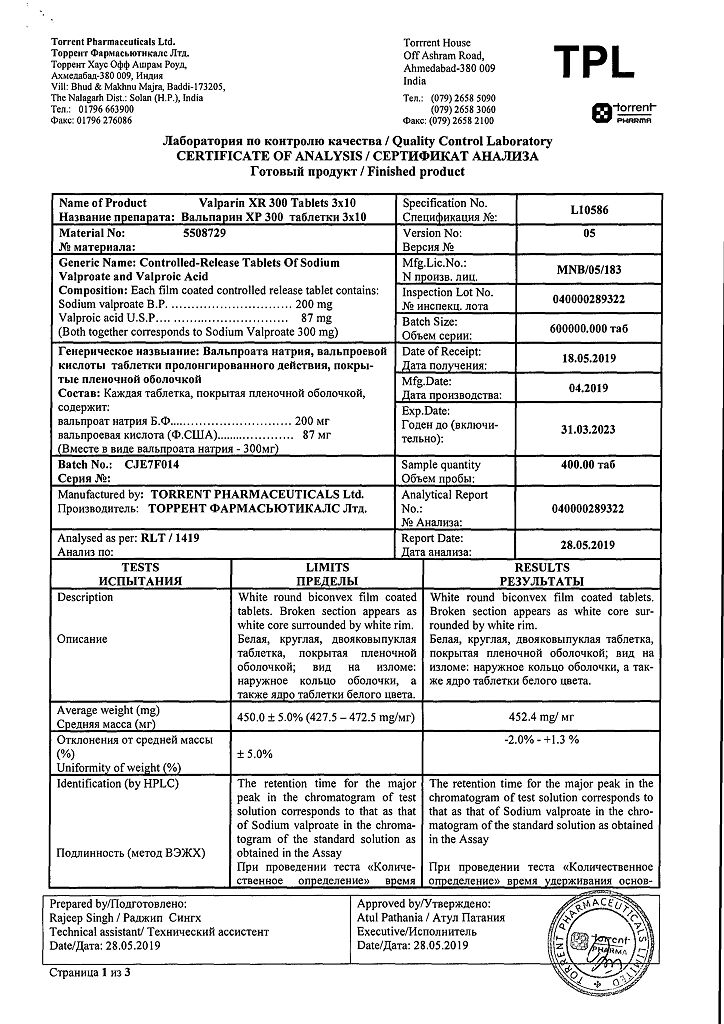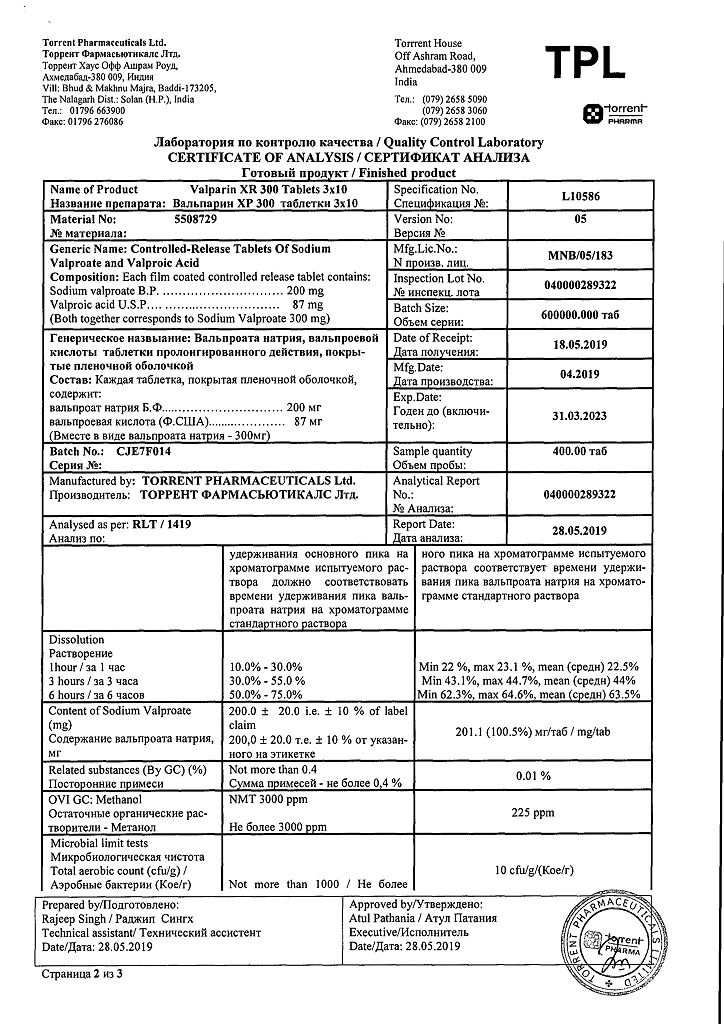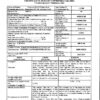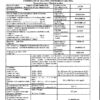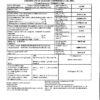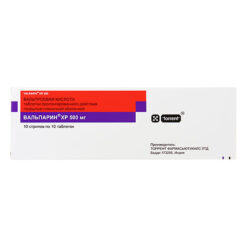No products in the cart.
Valparin XP, 300 mg 30 pcs
€1.00
Out of stock
(E-mail when Stock is available)
Description
Sodium valproate has anticonvulsant activity in various types of epilepsy in humans. The drug does not have pronounced hypnotic and sedative effects and has no depressant effect on the respiratory center. Valproate sodium has no adverse effect on BP, HR, renal function and body temperature.
Sodium valproate increases gamma-aminobutyric acid (GABA) levels in the brain, which consequently increases GABA levels in postsynaptic neurons. In addition, sodium valproate affects the transport of potassium ions across neuronal membranes. The result is the suppression of development as well as the spread of epileptic excitation through neurons.
Pharmacokinetics
Intake
After oral administration of controlled-release tablets, Cmax in plasma is reached within 2-8 h. The bioavailability of the drug is about 100%.
Therapeutic efficacy is seen at plasma concentrations of valproic acid 40-100 mg/l. The pharmacological and therapeutic effects of this controlled-release drug are not always dependent on its plasma concentration.
Distribution
The binding to plasma proteins is 80-90%.
Vd is 0.2 L/kg.
Metabolism and excretion
Metabolized in the liver and excreted in the urine. No presystemic metabolism is noted. T1/2 is approximately 8-20 h.
Pharmacokinetics in special clinical cases
In children, T1/2 is decreased.
Indications
Indications
Treatment of generalized or partial epilepsy, especially for the following types of seizures:
absence seizures;
myoclonic;
tonic-clonic;
atonic.
Partial epilepsy:
simple or combined seizures;
secondary generalized seizures.
Specific syndromes (Vest, Lennox-Gastaut).
Pharmacological effect
Pharmacological effect
Sodium valproate has anticonvulsant activity in various types of epilepsy in humans. The drug does not have pronounced hypnotic and sedative effects, and also does not have a depressing effect on the respiratory center. Sodium valproate does not have a negative effect on blood pressure, heart rate, kidney function and body temperature.
Sodium valproate increases the content of gamma-aminobutyric acid (GABA) in the brain, which correspondingly increases the content of GABA in postsynaptic neurons. In addition, sodium valproate affects the transport of potassium ions across neuronal membranes. As a result, the development and propagation of epileptic excitation along neurons is suppressed.
Pharmacokinetics
Suction
After oral administration of controlled-release tablets, Cmax in plasma is achieved within 2-8 hours. Bioavailability of the drug is about 100%.
Therapeutic effectiveness is manifested when the concentration of valproic acid in the blood plasma is 40-100 mg/l. The pharmacological and therapeutic effects of this controlled-release drug are not always dependent on its plasma concentration.
Distribution
Plasma protein binding is 80-90%.
Vd is 0.2 l/kg.
Metabolism and excretion
Metabolized in the liver and excreted in the urine. Presystemic metabolism is not observed. T1/2 is approximately 8-20 hours.
Pharmacokinetics in special clinical situations
In children, T1/2 decreases.
Special instructions
Special instructions
Regular monitoring of transaminase activity, bilirubin content, blood platelets, and amylase is necessary (every 3 months).
Valproic acid inhibits platelet aggregation, which increases the risk of increased clotting time during bleeding. The possibility of complications associated with bleeding in the postoperative period should be taken into account in patients receiving sodium valproate. With long-term use of sodium valproate, spontaneous hematomas and bleeding may develop. In this case, you should immediately stop taking the drug.
Sodium valproate can cause drug-induced pancreatitis and liver dysfunction (usually in the first 6 months of use). In this regard, during the first 23 months of treatment it is necessary to monitor the condition of the pancreas, perform liver tests, and monitor the level of prothrombin. Impaired liver function and liver failure during therapy with sodium valproate are sometimes observed in children with epilepsy and combined metabolic and degenerative diseases, organic pathology of brain tissue and delayed mental development. If symptoms such as severe weakness, lethargy, swelling, vomiting and jaundice occur, you should immediately stop using the drug.
Impact on the ability to drive vehicles and operate machinery
The patient should be careful when working with machinery, because the drug reduces the ability to concentrate.
Active ingredient
Active ingredient
Valproic acid
Composition
Composition
1 tab.
sodium valproate
200 mg
valproic acid
87 mg,
which corresponds to the total sodium valproate content
300 mg
Excipients:
colloidal silicon dioxide,
hydroxypropyl methylcellulose,
ethylcellulose,
silicon dioxide hydrate,
sodium saccharin,
glycerin,
titanium dioxide,
eudragit E-100,
eudragit NE-30D,
polyethylene glycol 1500,
talc.
Pregnancy
Pregnancy
Prescribing the drug during pregnancy is possible only if the expected benefit to the mother outweighs the potential risk to the fetus. If you take the drug during pregnancy, specialized prenatal monitoring of the fetus is mandatory.
The use of the drug during breastfeeding is not recommended.
Use in children
The drug is contraindicated in children under 3 years of age.
For children weighing more than 20 kg, the initial dose is 400 mg/day. The dose should be increased gradually until optimal values are reached – usually 20-30 mg/kg/day in 1 or 2 doses.
Valparin XP should not be used in children weighing up to 20 kg.
Contraindications
Contraindications
severe pancreatic dysfunction;
acute or chronic hepatitis, cases of active hepatitis in a family history (primarily of drug origin);
porphyria;
thrombocytopenia;
pregnancy;
lactation (breastfeeding);
children under 3 years of age;
hypersensitivity to valproic acid and other components of the drug.
Contraindicated in acute or chronic hepatitis, cases of active hepatitis in a family history (primarily drug-induced
In elderly patients, the dosage regimen of Valparin XP is similar to the dosage regimen in adults and is selected individually.
Side Effects
Side Effects
From the digestive system: rarely – nausea, vomiting, diarrhea and/or constipation, hepatitis, pancreatitis.
Allergic reactions: rarely – skin rash, itching, photosensitivity, erythema multiforme, Stevens-Johnson syndrome.
From the side of the central nervous system: rarely – ataxia, tremor, impaired consciousness, coma.
From the reproductive system: rarely – menstrual irregularities, secondary amenorrhea.
From the hematopoietic system: rarely – anemia, thrombocytopenia, neutropenia, leukopenia, decreased fibrinogen content, inhibition of platelet aggregation.
Other: 2-12% – hair loss; rarely – weight gain, hyperammonemia, creatininemia.
Interaction
Interaction
Sodium valproate enhances the effect of antipsychotic drugs, anticonvulsants and antidepressants. Unlike other anticonvulsants, sodium valproate does not induce liver enzymes and therefore does not reduce the effectiveness of oral contraceptives.
When used together, sodium valproate and warfarin reduce the percentage of binding to plasma proteins of the latter.
Sodium valproate alters plasma concentrations of phenytoin and lamotrigine. In combination with anticoagulants and acetylsalicylic acid derivatives, the antiplatelet effect is enhanced.
Overdose
Overdose
Rare cases of accidental or intentional overdose of the drug have been reported.
Symptoms: nausea, vomiting, dizziness, diarrhea, respiratory depression, hyporeflexia, coma.
Treatment: gastric lavage, taking activated carbon. If necessary, inpatient treatment with symptomatic therapy and hemodialysis.
Storage conditions
Storage conditions
In a dry place, at a temperature not exceeding 30 °C
Shelf life
Shelf life
3 years
Manufacturer
Manufacturer
Torrent Pharmaceuticals Ltd, India
Additional information
| Shelf life | 3 years |
|---|---|
| Conditions of storage | In a dry place, at a temperature no higher than 30 °C |
| Manufacturer | Torrent Pharmaceuticals Ltd, India |
| Medication form | slow-release tablets |
| Brand | Torrent Pharmaceuticals Ltd |
Other forms…
Related products
Buy Valparin XP, 300 mg 30 pcs with delivery to USA, UK, Europe and over 120 other countries.


